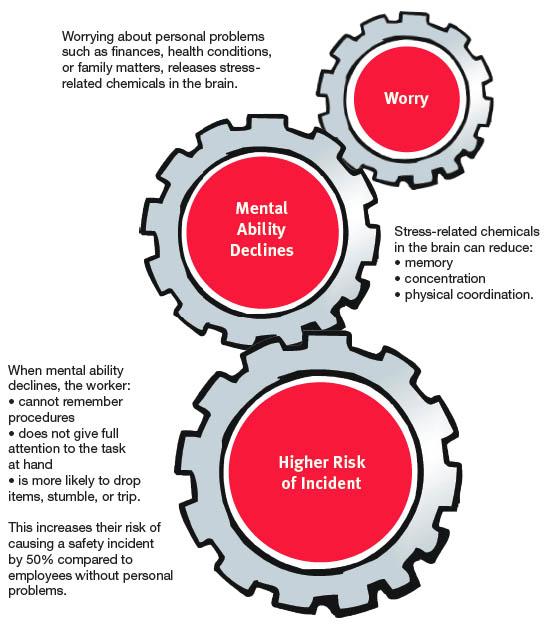
Why?
Worrying about personal problems harms his mental skills, especially memory and concentration.
Talking Points
- Are supervisors too shy to ask their workers about personal problems?
- Do we understand the risks involved in not knowing the mental state of our employees?
- Can supervisors assign high-risk individuals to lower-risk tasks?
This Safety Minute was prepared by Larkin Communication (www.larkin.biz) in partnership with CEP.
How Personal Problems Can Increase Risk

This Safety Minute was prepared by Larkin Communication (www.larkin.biz) in partnership with CEP.
Further Reading
Personal Problems Increase Risk by 50%
Research conducted by the U.K. Royal Navy
- Researchers measured the psychological stress of 153 employees of the U.K. Royal Navy using a questionnaire
- They asked the number of accidents employees had been involved in over a three-year period
- An accident was defined as an injury where the person missed three or more days of work
- Results showed that those people with higher levels of stress had significantly more accidents
- “Accident-prone” people had, on average, 50% more accidents
- People with numerous accidents also reported problems with:
- concentration
- remembering instructions
- physical coordination
Source: Visser, E., et al., “Accident Proneness, Does it Exist? A Review and Meta-Analysis,” Accident Analysis & Prevention, 39 (3), pp. 556–564, www.sciencedirect.com/science/article/abs/pii/S0001457506001746 (May 2007).
Source: Day, A., et al., “Accident Proneness Revisited: The Role of Psychological Stress and Cognitive Failure,” Accident Analysis & Prevention, 49, pp. 532–535, www.sciencedirect.com/science/article/abs/pii/S0001457512001170 (Nov. 2012).
3% of Employees Account for 22% of Accidents
Research conducted by Shell
- Researchers at the Shell complex in Deer Park, TX, studied five years of accident records (1981–1986)
- In this five-year span, 7,131 accidents occured:
- 392 of these accidents were major (OSHA recordable)
- 6,382 were minor (involved some injury)
- the remaining accidents involved no injury
- To eliminate some variability, the researchers grouped accidents according to job family:
- Operations — operator, lab tester
- Electrical — electrician, instrument mechanic
- Process — pipefitter, machinist
- Maintenance — boilermaker, welder
- Miscellaneous — carpenter, insulator, garage mechanic
- Result: 3.4% of employees accounted for 21.5% of accidents
- The number of employees with multiple accidents was much higher than what would be expected if the accidents were random
- Statistically, the number of employees who should have had 10 accidents during the five-year span is less than one. However, the actual number of employees who had 10 or more accidents during this period was 27
Source: Mayer, D. L., et al., “Accident Proneness in the Industrial Setting,” Proceedings of the Human Factors and Ergonomics Society Annual Meeting, 31, pp. 196–198, https://doi.org/10.1177/154193128703100213 (Sept. 1, 1987).
This Safety Minute was prepared by Larkin Communication (www.larkin.biz) in partnership with CEP.

Copyright Permissions
Would you like to reuse content from CEP Magazine? It’s easy to request permission to reuse content. Simply click here to connect instantly to licensing services, where you can choose from a list of options regarding how you would like to reuse the desired content and complete the transaction.
